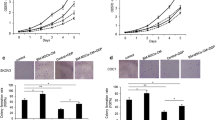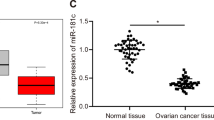Abstract
Background
Bone marrow-derived mesenchymal stem cells (BM-MSCs) play an important role in cancer development and progression. However, the mechanism by which they enhance the chemoresistance of ovarian cancer is unknown.
Methods
Conditioned media of BM-MSCs (BM-MSC-CM) were analyzed using a technique based on microRNA arrays. The most highly expressed microRNAs were selected for testing their effects on glycolysis and chemoresistance in SKOV3 and COC1 ovarian cancer cells. The targeted gene and related signaling pathway were investigated using in silico analysis and in vitro cancer cell models. Kaplan-Merier survival analysis was performed on a population of 59 patients enrolled to analyze the clinical significance of microRNA findings in the prognosis of ovarian cancer. Results: MiR-1180 was the most abundant microRNA detected in BM-MSC-CM, which simultaneously induces glycolysis and chemoresistance (against cisplatin) in ovarian cancer cells. The secreted frizzled-related protein 1 (SFRP1) gene was identified as a major target of miR-1180. The overexpression of miR-1180 led to the activation of Wnt signaling and its downstream components, namely Wnt5a, β-catenin, c-Myc, and CyclinD1, which are responsible for glycolysis-induced chemoresistance. The miR-1180 level was inversely correlated with SFRP1 mRNA expression in ovarian cancer tissue. The overexpressed miR-1180 was associated with a poor prognosis for the long-term (96-month) survival of ovarian cancer patients. Conclusions: BM-MSCs enhance the chemoresistance of ovarian cancer by releasing miR-1180. The released miR-1180 activates the Wnt signaling pathway in cancer cells by targeting SFRP1. The enhanced Wnt signaling upregulates the glycolytic level (i.e. Warburg effect), which reinforces the chemoresistance property of ovarian cancer cells.
概要
目的
已知骨髓间充质干细胞在癌症的发生发展中起有 重要作用, 本研究分析它们在增强卵巢癌化疗耐 药能力中的具体作用。
创新点
发现骨髓间充质干细胞可以通过释放微小RNA (microRNA)影响卵巢癌化疗耐药能力, 并确定 了介导此作用的microRNA 分子和相关作用机制。
方法
收集骨髓间充质干细胞条件培养基, 以微阵列方 法分析其中microRNA 表达谱。 针对所获高表达 microRNA, 分析它(们)对细胞内糖酵解及相关 化疗耐药行为的影响。 通过生物信息学方法查找 所获microRNA 的靶基因, 分析信号作用机制。 纳入59 名卵巢癌患者, 以Kaplan-Merier 生存分 析方法考察所获microRNA 分子表达程度的临床 预后意义。
结论
迁移至卵巢癌组织内的骨髓间充质干细胞可释放 miR-1180 分子。 MiR-1180 分子进入癌细胞后, 识别并下调SFRP1 蛋白(分泌型Wnt 受体, 起 信号抑制作用), 由此提高Wnt 通路活性。 活化 后的Wnt 信号通路可增强癌细胞内糖酵解水平 (即Warburg 效应), 从而引起糖酵解依赖性化 疗耐药行为。
Similar content being viewed by others
References
Abubaker K, Latifi A, Luwor R, et al., 2013. Short–term single treatment of chemotherapy results in the enrichment of ovarian cancer stem cell–like cells leading to an increased tumor burden. Mol Cancer, 12:24. https://doi.org/10.1186/1476-4598-12-24
Arend RC, Londoño–Joshi AI, Straughn JM Jr, et al., 2013. The Wnt/ß–catenin pathway in ovarian cancer:a review. Gynecol Oncol, 131(3):772–779. https://doi.org/10.1016/j.ygyno.2013.09.034
Barbolina MV, Burkhalter RJ, Stack MS, 2011. Diverse mechanisms for activation of Wnt signalling in the ovarian tumour microenvironment. Biochem J, 437(1):1–12. https://doi.org/10.1042/BJ20110112
Benabbou N, Mirshahi P, Bordu C, et al., 2014. A subset of bone marrow stromal cells regulate ATP–binding cassette gene expression via insulin–like growth factor–I in a leukemia cell line. Int J Oncol, 45(4):1372–1380. https://doi.org/10.3892/ijo.2014.2569
Burkhalter RJ, Symowicz J, Hudson LG, et al., 2011. Integrin regulation of ß–catenin signaling in ovarian carcinoma. J Biol Chem, 286(26):23467–23475. https://doi.org/10.1074/jbc.M110.199539
Cai JY, Wang JC, Huang YN, et al., 2016. ERK/Drp1–dependent mitochondrial fission is involved in the MSCinduced drug resistance of T–cell acute lymphoblastic leukemia cells. Cell Death Dis, 7(11):e2459. https://doi.org/10.1038/cddis.2016.370
Castells M, Milhas D, Gandy C, et al., 2013. Microenvironment mesenchymal cells protect ovarian cancer cell lines from apoptosis by inhibiting XIAP inactivation. Cell Death Dis, 4(10):e887. https://doi.org/10.1038/cddis.2013.384
Chen EG, Zhang JS, Xu S, et al., 2017. Long non–coding RNA DGCR5 is involved in the regulation of proliferation, migration and invasion of lung cancer by targeting miR–1180. Am J Cancer Res, 7(7):1463–1475.
Coffman LG, Choi YJ, McLean K, et al., 2016. Human carcinoma–associated mesenchymal stem cells promote ovarian cancer chemotherapy resistance via a BMP4/HH signaling loop. Oncotarget, 7(6):6916–6932. https://doi.org/10.18632/oncotarget.6870
Das B, Kashino SS, Pulu I, et al., 2013. CD271+ bone marrow mesenchymal stem cells may provide a niche for dormant Mycobacterium tuberculosis. Sci Transl Med, 5(170):170ra13. https://doi.org/10.1126/scitranslmed.3004912
Fu DL, Jiang QH, He FM, et al., 2017. Adhesion of bone marrow mesenchymal stem cells on porous titanium surfaces with strontium–doped hydroxyapatite coating. J Zhejiang Univ–Sci B (Biomed & Biotechnol), 18(9):778–788. https://doi.org/10.1631/jzus.B1600517
Ganapathy–Kanniappan S, Geschwind JF, 2013. Tumor glycolysis as a target for cancer therapy:progress and prospects. Mol Cancer, 12:152. https://doi.org/10.1186/1476-4598-12-152
Ge QQ, Wang CH, Chen Z, et al., 2017. The suppressive effects of miR–1180–5p on the proliferation and tumorigenicity of bladder cancer cells.Histol Histopathol, 32(1):77–86. https://doi.org/10.14670/HH-11-772
Gu L, Zhang JQ, Shi MM, et al., 2017. The effects of miRNA–1180 on suppression of pancreatic cancer. Am J Transl Res, 9(6):2798–2806.
He YF, Zhu QJ, Chen M, et al., 2016. The changing 50% inhibitory concentration (IC50) of cisplatin:a pilot study on the artifacts of the MTT assay and the precise measurement of density–dependent chemoresistance in ovarian cancer. Oncotarget, 7(43):70803–70821. https://doi.org/10.18632/oncotarget.12223
Huang RX, Wu D, Yuan Y, et al., 2014. CD117 expression in fibroblasts–like stromal cells indicates unfavorable clinical outcomes in ovarian carcinoma patients. PLoS ONE, 9(11):e112209. https://doi.org/10.1371/journal.pone.0112209
Icard P, Shulman S, Farhat D, et al., 2018. How the Warburg effect supports aggressiveness and drug resistance of cancer cells? Drug Resist Updat, 38:1–11. https://doi.org/10.1016/j.drup.2018.03.001
Jones EA, Crawford A, English A, et al., 2008. Synovial fluid mesenchymal stem cells in health and early osteoarthritis:detection and functional evaluation at the single–cell level. Arthritis Rheum, 58(6):1731–1740. https://doi.org/10.1002/art.23485
Latifi A, Abubaker K, Castrechini N, et al., 2011. Cisplatin treatment of primary and metastatic epithelial ovarian carcinomas generates residual cells with mesenchymal stem cell–like profile. J Cell Biochem, 112(10):2850–2864. https://doi.org/10.1002/jcb.23199
Lis R, Touboul C, Mirshahi P, et al., 2011. Tumor associated mesenchymal stem cells protects ovarian cancer cells from hyperthermia through CXCL12. Int J Cancer, 128(3):715–725. https://doi.org/10.1002/ijc.25619
Lis R, Touboul C, Halabi NM, et al., 2014. Mesenchymal cell interaction with ovarian cancer cells induces a background dependent pro–metastatic transcriptomic profile. J Transl Med, 12:59. https://doi.org/10.1186/1479-5876-12-59
Mader EK, Maeyama Y, Lin Y, et al., 2009. Mesenchymal stem cell carriers protect oncolytic measles viruses from antibody neutralization in an orthotopic ovarian cancer therapy model. Clin Cancer Res, 15(23):7246–7255. https://doi.org/10.1158/1078-0432.CCR-09-1292
McLean K, Gong YS, Choi Y, et al., 2011. Human ovarian carcinoma–associated mesenchymal stem cells regulate cancer stem cells and tumorigenesis via altered BMP production. J Clin Invest, 121(8):3206–3219. https://doi.org/10.1172/JCI45273
Munoz JL, Rodriguez–Cruz V, Walker ND, et al., 2015. Temozolomide resistance and tumor recurrence:halting the Hedgehog. Cancer Cell Microenviron, 2(2):e747. https://doi.org/10.14800/ccm.747
Noort WA, Oerlemans MIFJ, Rozemuller H, et al., 2012. Human versus porcine mesenchymal stromal cells:phenotype, differentiation potential, immunomodulation and cardiac improvement after transplantation. J Cell Mol Med, 16(8):1827–1839. https://doi.org/10.1111/j.1582-4934.2011.01455.x
Pate KT, Stringari C, Sprowl–Tanio S, et al., 2014. Wnt signaling directs a metabolic program of glycolysis and angiogenesis in colon cancer.EMBO J, 33(13):1454–1473. https://doi.org/10.15252/embj.201488598
Quirici N, Soligo D, Bossolasco P, et al., 2002. Isolation of bone marrow mesenchymal stem cells by anti–nerve growth factor receptor antibodies.Exp Hematol, 30(7):783–791. https://doi.org/10.1016/S0301-472X(02)00812-3
Rasini V, Dominici M, Kluba T, et al., 2013. Mesenchymal stromal/stem cells markers in the human bone marrow. Cytotherapy, 15(3):292–306. https://doi.org/10.1016/j.jcyt.2012.11.009
Ridge SM, Sullivan FJ, Glynn SA, 2017. Mesenchymal stem cells:key players in cancer progression. Mol Cancer, 16:31. https://doi.org/10.1186/s12943-017-0597-8
Suh DH, Kim HS, Kim B, et al., 2014. Metabolic orchestration between cancer cells and tumor microenvironment as a co–evolutionary source of chemoresistance in ovarian cancer:a therapeutic implication. Biochem Pharmacol, 92(1):43–54. https://doi.org/10.1016/j.bcp.2014.08.011
Takahashi–Yanaga F, Kahn M, 2010. Targeting Wnt signaling:can we safely eradicate cancer stem cells? Clin Cancer Res, 16(12):3153–3162. https://doi.org/10.1158/1078-0432.CCR-09-2943
Tan GS, Wu LW, Tan JF, et al., 2016. MiR–1180 promotes apoptotic resistance to human hepatocellular carcinoma via activation of NF–?B signaling pathway. Sci Rep, 6:22328. https://doi.org/10.1038/srep22328
Touboul C, Lis R, al Farsi H, et al., 2013. Mesenchymal stem cells enhance ovarian cancer cell infiltration through IL6 secretion in an amniochorionic membrane based 3D model. J Transl Med, 11:28. https://doi.org/10.1186/1479-5876-11-28
Touboul C, Vidal F, Pasquier J, et al., 2014. Role of mesenchymal cells in the natural history of ovarian cancer:a review. J Transl Med, 12:271. https://doi.org/10.1186/s12967-014-0271-5
Tyciakova S, Matuskova M, Bohovic R, et al., 2015. Genetically engineered mesenchymal stromal cells producing TNFa have tumour suppressing effect on human melanoma xenograft. J Gene Med, 17(1–2): 54–67. https://doi.org/10.1002/jgm.2823
Vallabhaneni KC, Hassler MY, Abraham A, et al., 2016. Mesenchymal stem/stromal cells under stress increase osteosarcoma migration and apoptosis resistance via extracellular vesicle mediated communication. PLoS ONE, 11(11):e0166027. https://doi.org/10.1371/journal.pone.0166027
Wang CH, Chen Z, Ge QQ, et al., 2014. Up–regulation of p21WAF1/CIP1 by miRNAs and its implications in bladder cancer cells. FEBS Lett, 588(24):4654–4664. https://doi.org/10.1016/j.febslet.2014.10.037
Wang WW, Zhong W, Yuan JH, et al., 2015. Involvement of Wnt/ß–catenin signaling in the mesenchymal stem cells promote metastatic growth and chemoresistance of cholangiocarcinoma. Oncotarget, 6(39):42276–42289. https://doi.org/10.18632/oncotarget.5514
Warburg O, 1956. On the origin of cancer cells. Science, 123(3191):309–314. https://doi.org/10.1126/science.123.3191.309
Watson JT, Foo T, Wu J, et al., 2013. CD271 as a marker for mesenchymal stem cells in bone marrow versus umbilical cord blood. Cells Tissues Organs, 197(6):496–504. https://doi.org/10.1159/000348794
Watts TL, Cui RW, Szaniszlo P, et al., 2016. PDGF–AA mediates mesenchymal stromal cell chemotaxis to the head and neck squamous cell carcinoma tumor microenvironment. J Transl Med, 14(1):337. https://doi.org/10.1186/s12967-016-1091-6
Wu H, Ding ZH, Hu DQ, et al., 2012. Central role of lactic acidosis in cancer cell resistance to glucose deprivationinduced cell death. J Pathol, 227(2):189–199. https://doi.org/10.1002/path.3978
Wu M, Neilson A, Swift AL, et al., 2007. Multiparameter metabolic analysis reveals a close link between attenuated mitochondrial bioenergetic function and enhanced glycolysis dependency in human tumor cells. Am J Physiol Cell Physiol, 292(1): C125–C136. https://doi.org/10.1152/ajpcell.00247.2006
Xiang BY, Chen L, Wang XJ, et al., 2017. Mesenchymal stem cells as therapeutic agents and in gene delivery for the treatment of glioma. J Zhejiang Univ–Sci B (Biomed & Biotechnol), 18(9):737–746. https://doi.org/10.1631/jzus.B1600337
Yang YY, Otte A, Hass R, 2015. Human mesenchymal stroma/ stem cells exchange membrane proteins and alter functionality during interaction with different tumor cell lines. Stem Cells Dev, 24(10):1205–1222. https://doi.org/10.1089/scd.2014.0413
Yao K, Fu XF, Du X, et al., 2018. PGC–1a coordinates with Bcl–2 to control the cell cycle in U251 cells through reducing ROS. J Zhejiang Univ–Sci B (Biomed & Biotechnol), 19(6):415–424. https://doi.org/10.1631/jzus.B1700148
Yao ZY, Chen WB, Shao SS, et al., 2018. Role of exosomeassociated microRNA in diagnostic and therapeutic applications to metabolic disorders.J Zhejiang Univ–Sci B (Biomed & Biotechnol), 19(3):183–198. https://doi.org/10.1631/jzus.B1600490
Zhang MY, He YF, Sun XJ, et al., 2014. A high M1/M2 ratio of tumor–associated macrophages is associated with extended survival in ovarian cancer patients. J Ovarian Res, 7:19. https://doi.org/10.1186/1757-2215-7-19
Zhou X, Zhu HQ, Ma CQ, et al., 2016. MiR–1180 promoted the proliferation of hepatocellular carcinoma cells by repressing TNIP2 expression.Biomed Pharmacother, 79:315–320. https://doi.org/10.1016/j.biopha.2016.02.025
Zhu DY, Gao WX, Zhang ZM, 2018. MicroRNA–1180 is associated with growth and apoptosis in prostate cancer via TNF receptor associated factor 1 expression regulation and nuclear factor-B signaling pathway activation.Oncol Lett, 15(4):4775–4780. https://doi.org/10.3892/ol.2018.7914
Author information
Authors and Affiliations
Corresponding authors
Additional information
Project supported by the National Key Research and Development Program of China (No. 2016YFC1303100), the Science and Technology Commission of Shanghai Municipality (Nos. 15441905700, 15DZ1940502, and 12411950200), the Shanghai Municipal Commission of Health and Family Planning (No. 2013ZYJB0202), and the National Natural Science Foundation of China (Nos. 81572548, 81772770, 81272882, and 81072137)
Rights and permissions
About this article
Cite this article
Gu, ZW., He, YF., Wang, WJ. et al. MiR-1180 from bone marrow-derived mesenchymal stem cells induces glycolysis and chemoresistance in ovarian cancer cells by upregulating the Wnt signaling pathway. J. Zhejiang Univ. Sci. B 20, 219–237 (2019). https://doi.org/10.1631/jzus.B1800190
Received:
Revised:
Accepted:
Published:
Issue Date:
DOI: https://doi.org/10.1631/jzus.B1800190
Key words
- Chemoresistant ovarian cancer
- Mesenchymal stem cell
- MiR-1180
- Secreted frizzled-related protein 1 (SFRP1)
- Wnt
- Glycolysis




